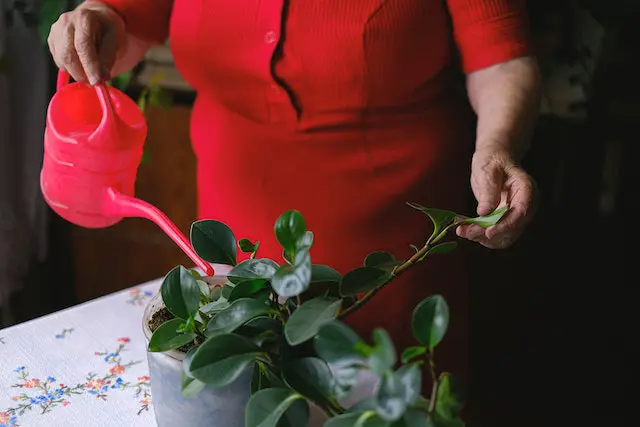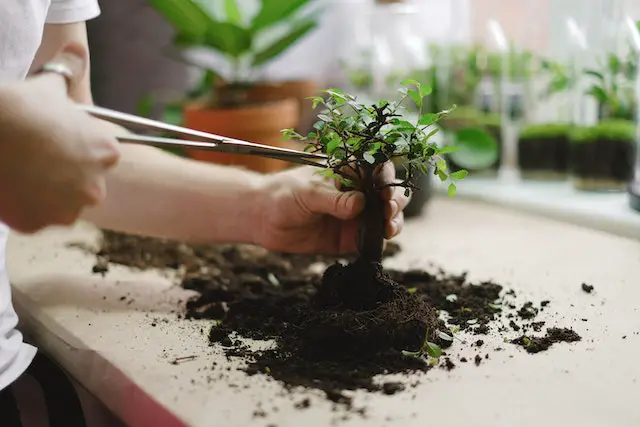Houseplants like Aglaonemas (Chinese evergreens) are popular for their decorative purposes, owing to their beautiful patterns. In addition, this houseplant is equally the kind that’s tough and pretty easy to maintain.
If you suddenly witness severe leaf and stem drooping on your plant, it can be scary. However, when issues like your Aglaonema drooping suddenly arise, you might want to know why it happened.
Why is My Aglaonema Drooping?

Aglaonema starts to droop, mostly if they get too little or too much water. Besides problems with water, drooping can occur as a result of a change in temperature, transplant shock, or a lack of nutrients.
Identifying the particular reason for drooping in your Chinese evergreens will make it easier to resolve the issue. In this article, we will discuss the different causes of drooping in Aglaonema plants as well as the solutions.
Read further to find them out!
6 Possible Reasons Why Your Aglaonema Plant Is Drooping
1. Overwatering
Excess water in the soil is a major cause of Aglaonema drooping, so we should look at this first. It’s bad when the soil of this plant contains too much water. This condition can cause its roots to begin to rot.
A decaying root can have an impact on other parts of the plant. The stems and leaves of your Aglaonema may begin to droop. Most of the time, the leaves will turn yellow too.
If your plant soil has excess water in it, try repotting it. However, it’s better to use a pot with drainage holes. It helps to tackle the issue of overwatered soil.
In addition, you should only water the plant when necessary. This means that you should always check the soil and only water when it’s no longer moist.
2. Underwatering

Underwatering is another major cause of drooping, not just in Aglaonema but also in other houseplants. This water issue results in dry soil, which isn’t good for Aglaonemas. If this happens, their stems and leaves will begin to wilt and dry up.
Furthermore, this can lead to the death of your Aglaonema. If you notice that your Aglaonema is suffering from dry soil, fix this by soaking the plant and soil.
At intervals, water it while checking the soil to see if it’s moist enough. Check for moisture by inserting a wooden stick into the soil.
It is important that you water this houseplant often to prevent this from happening. It’s not a good thing if your plants suffer from a lack of water constantly.
3. Lack Of Warmth
Aglaonemas are the kinds that love heat a lot. These houseplants thrive in temperatures ranging from 65 to 80° Fahrenheit. Your Aglaonema wouldn’t do well in temperatures below 60° Fahrenheit.
Cold temperatures greatly affect this plant, even if you expose them to it for a short time. These conditions can make them droop easily. So, if you are in a cold environment, your Aglaonema can wither easily.
You might want to keep these plants above ground. If it’s by the window, make sure it’s not getting a chilly wind.
4. Unsuitable Lighting Conditions

Keep in mind that the Aglaonema plants don’t like bright, direct sunlight. These plants are known to tolerate any light condition, including low sunlight, which is incredible.
However, intense sunlight is one light condition they can’t stand. It can cause both their stems and leaves to start drooping. In addition, these plants might thrive in low light conditions, but it’s bad if they lack sunlight.
Aglaonemas need sunlight to create food, and when they lack it, they’ll starve. One of the symptoms is the drooping of leaves and stems.
Make sure your Aglaonema receives adequate sunlight. However, place it in areas where it gets indirect but bright sunlight. This can be as simple as just moving it a few feet away from a very sunny window.
5. Lack Of Nutrition
Drooping can also indicate that your Aglaonema plant is lacking the nutrients it needs. So your goal here is to restore nutrients to their plants and soil.
It’s either you use compost or fertilizer for the soil. But don’t add too many fertilizers, especially chemical ones, as they could cause the plants to wither even more.
6. Transplant Shock

Another cause of the Aglaonema drooping issue is the shock it gets from repotting or transplanting. When you repot your Aglaonema plant, it might react the same way it does when you move it.
However, your plant would need to adapt gradually to the new changes. All you have to do is make sure it’s under favorable conditions—good lighting, warmth, and proper watering. With this, it should be fine in a few days unless you didn’t replant it correctly.
Furthermore, repotting your Aglaonema plant often isn’t necessary. Mostly re-pot your houseplants when you need to. In addition, transplanting every 2-3 years is enough, especially around spring.
Also see: Why Is My ZZ Plant Drooping
Final Thoughts
Now, we’re sure you know the different reasons why your Aglaonema is drooping and how to resolve them. Watering is important for the plants; avoid underwatering or overwatering them.
In addition, keep an eye on the lighting your Aglaonema receives. Don’t forget that they need indirect lighting as they can’t tolerate full sunlight.
It’s equally important that this plant stays warm at all times. Do all of these and you’ll be able to resolve the Aglaonema drooping issue in no time.
Aglaonema is a tough plant that requires less care and attention to do well. However, if they experience drooping and some other dreadful conditions, they’ll need your help to get better again.
Frequently Asked Questions
How Do You Revive Drooping In Aglaonema?
Reviving your drooping Aglaonema is easy when you know the main cause. Excess water, underwatering, nutrient deficiency, and many other factors can cause this problem. It might be hard to pinpoint the main cause, so you need to try different measures to resolve this problem.
Begin by watering this plant properly. Moreover, instead of a watering schedule, water the plant anytime it feels dry or lacks moisture.
Then, drain the soil if it contains excess water. Besides, you can also repot the plant for a fresh start. In addition to this, make sure you provide the plant with the right amount of fertilizers.
Aglaonema plants equally need to get enough warmth, especially if they stay in a cold environment. Furthermore, keep the plant where it’ll receive indirect sunlight. Your Aglaonema should be fine in no time after most of these conditions are met.
How Do I Know If My Aglaonema is Dying?
A dying Aglaonema will have a poor root system, which can start to rot. Moreover, you will notice the stem and leaves drying up and wilting. Leaves will lose their color; they will turn yellow, brown, or even spotted.
If an Aglaonema is dying, it can have stunted growth. There can also be no sign of active growth, such as newly sprouted leaves or flowers.
How Often Should I Water Aglaonema?
Aglaonema plants only need water in moderate amounts. Water them once a week or two and deep enough to make sure the soil soaks properly.
In addition to this, use pots with drainage holes only. And make sure water comes out of the holes while watering. Just make sure you don’t overwater the Aglaonema to prevent root rot. On the other hand, don’t underwater the plant to prevent dehydration.

Hey, I’m Lisa and I’ve been an avid gardener for over 30 years. I love writing, talking and living in the garden! Feel free to connect with me on my socials below

